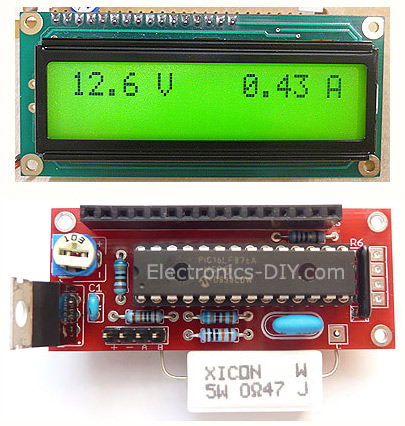Although the LM-317 power regulator will kick in on shortcircuit, overload and thermal overheating, the fuses in the primary section of the transformer and the fuse F2 at the output will secure your power supply. The rectified voltage of: 30 volt x SQR2 = 30 x 1.41 = 42.30 volt measured on C1. So all capacitors should be rated at 50 volts. Caution: 42 volt is the voltage that could be on the output if one of the transistors should blow.
P1 allows you to 'regulate' the output voltage to anything between 0 and 28 volts. The LM317 lowest voltage is 1.2 volt. To have a zero voltage on the output I've put 3 diodes D7,D8 and D9 on the output of the LM317 to the base of the 2N3055 transistors. The LM317 maximum output voltage is 30 volts, but using the diodes D7,D8 & D9 the output voltage is approx 30v - (3x 0.6v) = 28.2volt.
Calibrate your build-in voltmeter using P3 and, of course, a good digital voltmeter.
P2 will allow you to set the limit of the maximum available amps at the output +Vcc. When using a 100 Ohm/1watt varistat the current is limited to approx. 3 Amps @ 47 Ohm and +- 1 Amp @ 100 Ohms.
Note:
The collectors of the finals needs to be soldered with a wire all together if the transistors even if they are isolated from the heatsink or not. If you do not isolated the finals from the heatsink, then please make sure the heatsink does not make contact with the chassis (metal casing where you plan to build the PS into).
Remember to use thick wires suitable for transfering the current needed according to the power supply you tend to build.
Part list for 6/8 Amp regulatable power supply (PSR28A68):
2 x 15 volt (30volt total) 6+- amps
D1...D4 = four MR750 (MR7510) diodes (MR750 = 6 Ampere diode) or 2 x 4 1N5401 (1N5408) diodes.
F1 = 1 Amp
F2 = 10 amp
R1 2k2 2,5 Watt
R2 240 ohm
R3,R4 0.1 ohm 10 watt
R7 6k8
R8 10k
R9 47 0.5 watt
R10 8k2
C1,C7,C9 47nF
C11 22nF
C2 two times 4700uF/50v
C3,C5 10uF/50v
C4,C6 100nF
C8 330uF/50v
C10 1uF/16v
D5 1N4148, 1N4448, 1N4151
D6 1N4001
D10 1N5401
D11 LED
D7, D8, D9 1N4001
IC1 LM317
Two 2N3055 transistors
P1 5k
P2 47 Ohm or 220 Ohm 1 watt * (be sure you can reach 0 ohms as any resistance limits the current)
P3 10k trimmer
Calibration:
- Get your hands on a calibrated digital meter or a good analog meter and measure the voltage at the output of the power supply.
- Turn P1 to maximum (maximum voltage of our power supply).
- Adjust P3 till the meter needle shows maximum result (end scale)
- If you want to calibrate the scale, turn P1 to several voltages (like every volt) and confirm each time with your calibrated voltage meter. Make a mark on your power supply meter-scale to calibrate the meter.
- You should see equal spaced voltage marks on your home-made scale if your meter is a linear type.
Less maximum output voltage needed?
In operation, the LM317 develops a nominal 1.25V reference voltage, VREF, between the output and adjustment terminal.
The reference voltage is impressed across program resistor R1 and, since the voltage is constant, a constant current I1 then flows through the output set resistor R2, giving an
output voltage of
Since the 100 uA current from the adjustment terminal represents an error term, the LM317 was designed to minimize IADJ and make it very constant with line and load changes.
To do this, all quiescent operating current is returned to the output establishing a minimum load current requirement. If there is insufficient load on the output, the output will rise.
Less amps needed?
Well, without much modification you can:
- only one 2N3055, will give you 4...5 amps.
- the bridge rectifier (D1...D4) only needs 4 x 1N5401 (any +/- 3 amp diodes as only halve of the max. amp is needed, so we have some room when short-circuited)
- one 4700uF (C2) is sufficient
- F2 = 6 amp
- D5, D10 = 1N4001
The power supply insides
Heat sink
Remember to isolate the transistors from the chassis/radiator! Use a radiator (heat sink) of appropriate size and surface area; insulating and heat-conducting spacer or at least a thin mica; hot adhesive and thermal paste.
Finished power supply:
Note: You can add a 3th 2N3055 and use for R9=27 Ohm, to make a 10/12 ampere power supply of the design stated above.
PIC Volt Ampere Meter Kit
 PIC Volt Ampere Meter
PIC Volt Ampere Meter was designed to measure output voltage of 0-70V or 0-500V with 100mV resolution and 0-10A or more current with 10mA resolution. It is a perfect addition to any DIY laboratory power supply, battery chargers and other electronic projects where voltage and current consumption must be monitored. Thanks to added calibration via SETUP, UP & DOWN buttons it is now possible to calibrate the meter to measure voltage that is higher than 70V and current that is greater than 10A.
More Info ...